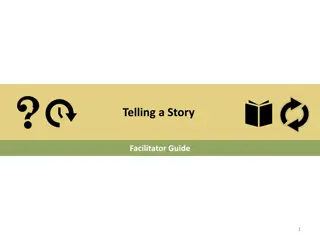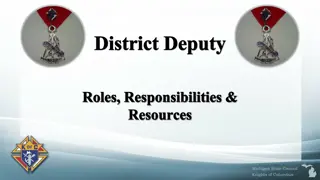Maintaining Neutrality as a Facilitator in Collaborative Meetings
When a facilitator maintains neutrality in collaborative meetings, it allows all voices to be heard, encourages collective intelligence, and fosters fairness and inclusivity. Developing neutrality involves self-reflection, seeking diverse perspectives, questioning assumptions, and practicing empathy.
Download Presentation

Please find below an Image/Link to download the presentation.
The content on the website is provided AS IS for your information and personal use only. It may not be sold, licensed, or shared on other websites without obtaining consent from the author.If you encounter any issues during the download, it is possible that the publisher has removed the file from their server.
You are allowed to download the files provided on this website for personal or commercial use, subject to the condition that they are used lawfully. All files are the property of their respective owners.
The content on the website is provided AS IS for your information and personal use only. It may not be sold, licensed, or shared on other websites without obtaining consent from the author.
E N D
Presentation Transcript
Maintaining Maintaining Neutrality as a Neutrality as a Facilitator Facilitator
What does it mean? What does it mean? When the facilitator of a collaborative meeting brings the objective and unbiased view to a group process, so that all voices can be heard and the team can access its collective intelligence. Source: 3 Great Ways to Maintain Neutrality in Meetings as the Facilitator - Team Catapult
Why is it Why is it important? important? It creates an environment of fairness and inclusivity. It ensures that all participants feel respected and have an equal opportunity to contribute. It fosters open dialogue by creating a safe space where individuals can freely express their thoughts and opinions. It is vital in conflict resolution, as it helps facilitators navigate disputes without bias, guiding participants toward mutual understanding. It builds trust among participants, promote fairness in decision-making, and minimize power dynamics in conflicts. Source: 3 Great Ways to Maintain Neutrality in Meetings as the Facilitator - Team Catapult
How do you develop neutrality? How do you develop neutrality? 1.Self Reflection Take the time to reflect on your own beliefs, biases, and emotions Source: 3 Great Ways to Maintain Neutrality in Meetings as the Facilitator - Team Catapult
How do you develop neutrality? (contd) How do you develop neutrality? (cont d) 2. Seek diverse perspectives Actively expose yourself to a range of viewpoints and opinions, especially those that differ from your own Source: 3 Great Ways to Maintain Neutrality in Meetings as the Facilitator - Team Catapult
How do you develop neutrality? contd How do you develop neutrality? cont d 3. Question your assumptions Challenge your own assumptions and preconceived notions Source: 3 Great Ways to Maintain Neutrality in Meetings as the Facilitator - Team Catapult
How do you develop neutrality? Contd How do you develop neutrality? Cont d 4. Practice Empathy Try to understand and empathize with the experiences, emotions, and motivations of others, even if you disagree with them. Source: 3 Great Ways to Maintain Neutrality in Meetings as the Facilitator - Team Catapult
How do you develop neutrality? Contd How do you develop neutrality? Cont d 5. Verify Information Ensure that the information you rely on is accurate and reliable. Fact-check claims and seek out reputable sources of information Source: 3 Great Ways to Maintain Neutrality in Meetings as the Facilitator - Team Catapult
How do you develop neutrality? Contd How do you develop neutrality? Cont d 6. Engage in critical thinking Develop your critical thinking skills to evaluate information and arguments objectively. Source: 3 Great Ways to Maintain Neutrality in Meetings as the Facilitator - Team Catapult
How do you develop neutrality? How do you develop neutrality? Cont d Cont d 7. Practice emotional detachment While acknowledging your emotions is important, strive to separate your emotions from your analysis of a situation Source: 3 Great Ways to Maintain Neutrality in Meetings as the Facilitator - Team Catapult
How do you develop neutrality? Contd How do you develop neutrality? Cont d 8. Consider long-term consequences Look beyond immediate outcomes and consider the potential long-term effects of different positions or decisions Source: 3 Great Ways to Maintain Neutrality in Meetings as the Facilitator - Team Catapult
How do you develop neutrality? Contd How do you develop neutrality? Cont d 9. Stay Informed Continuously educate yourself on various topics and stay informed about current events. Source: 3 Great Ways to Maintain Neutrality in Meetings as the Facilitator - Team Catapult
How do you develop neutrality? Contd How do you develop neutrality? Cont d 10. Practice patience and humility Developing neutrality is an ongoing process, and its important to be patient with yourself Source: 3 Great Ways to Maintain Neutrality in Meetings as the Facilitator - Team Catapult
Key steps when working with D Di iv ve er rs si it ty y Use language that fosters trust and alliance. Don t come on like gangbusters . Each person wants to succeed in this venture. Be calm and positive. When conflicts arise, the problem may result from style rather than content strive for understanding. Review, revise, and revisit your main objective to be certain the content is clear. How you say something may be important than WHAT you say. Learn to Listen. Listen for what is really being said, not what you want to hear Invite others to be a part of the discussion Learn to communicate clearly and fairly Do not misjudge people because of accent or grammar Test for understanding. Ask questions to be certain you are clear on what is being said Adapt your communication style to fit the situation. The telephone causes problems in understanding between cultures. Be explicit. Individuals from different cultures may react differently. Know with whom you are communicating. Source: factsheet704.pdf (usu.edu)























